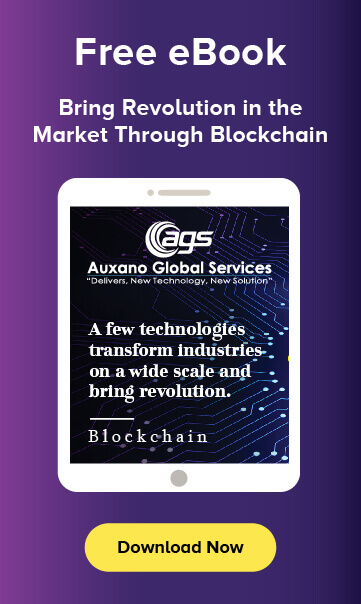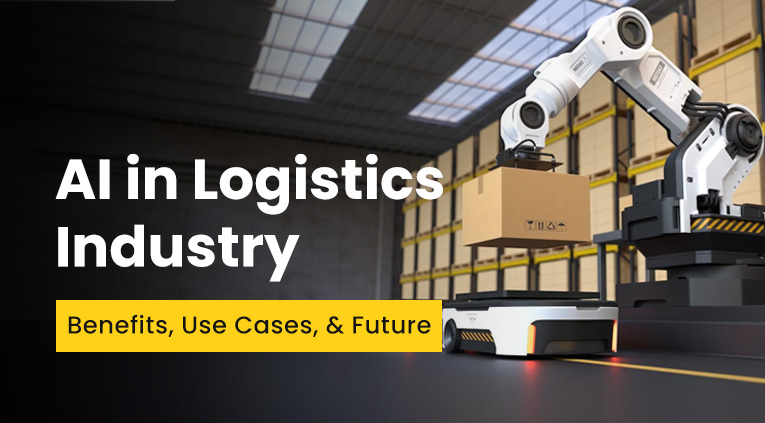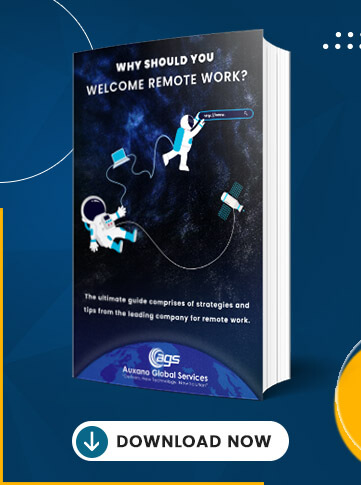Out of all the legs of the logistics process, last-mile delivery is the most important one. This is also one of the most expensive, inefficient, and tedious steps in delivering a package.
Today, more and more LSPs (logistics service providers) are looking for ways to optimize last-mile delivery. One way to do so is to build a last-mile delivery software. This software can turn last-mile delivery from being an additional cost into a brand’s identity.
In this blog, we have provided A-Z information on last-mile delivery software development. Do read this blog until the end to know the need for a last-mile delivery software, its features, development cost, and more.
Last-mile Delivery Decoded: Understanding Market Stats and Potential
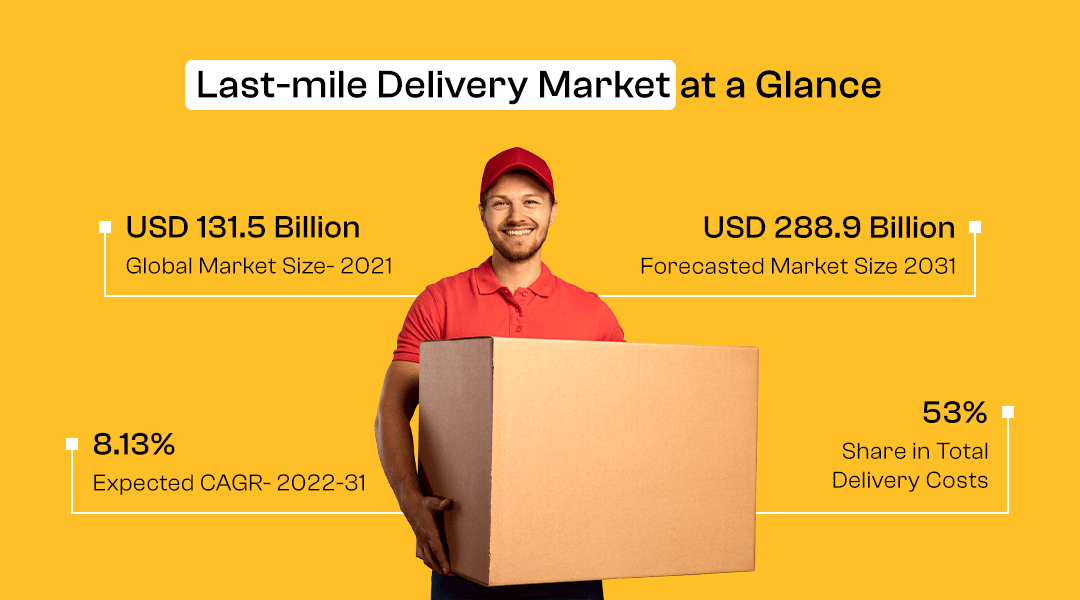
In simple words, last-mile delivery is the final stage of the delivery process. This step involves transporting the package from the final shipment destination (a warehouse or a retail store) to the customer’s doorstep.
What makes last-mile delivery a problem for most logistics businesses is the fact that here, logistics companies have to spend additional resources (fuel, human resources, etc.) on delivering a single package.
This is in contrast to other steps of the delivery process, where multiple, probably hundreds, of packages are transported altogether. Apart from this, several other challenges come with last-mile delivery. This includes delivery delays, unpredictable demand, lack of tracking, etc.
One way to overcome these challenges is to develop a last-mile delivery software. These software, owing to their smart nature, come in handy for automating, optimizing, and streamlining last-mile deliveries.
As a matter of fact, last-mile delivery software is a technology worth USD 7 billion as of 2021. These figures are expected to reach the USD 16 billion mark by 2030 (9.3% CAGR for the period 2022-30).
You must be wondering, “How exactly do last-mile delivery software benefit LSPs”, right? Well, that varies from one type of last-mile delivery software to the other.
Generally speaking, there are two types of last-mile delivery software- custom-build software and third-party (SaaS) software. The coming section will shed light on these types.
Custom Last-mile Delivery Software Development vs. Third-party Solutions: Which One to Choose?
Custom software engineering and purchasing readymade software are two of the most popular ways to embrace technology. Which of these approaches will be ideal for your logistics business depends on numerous factors.
Nevertheless, there are certain obvious differences that you must know. Doing so will help you determine the best way to undertake last-mile delivery software development.
Throughout this section, we will compare custom software with their readymade counterpart to find out the best-fitting approach. Let’s start by understanding third-party last-mile delivery software.
1. Third-party Last-mile Software
These are ready-to-use SaaS-based products that you can directly integrate into your organization. Third-party last-mile delivery software are developed by IT product companies and are popularly used in the market. Let’s discuss the benefits and limitations of these software to gain a better understanding.
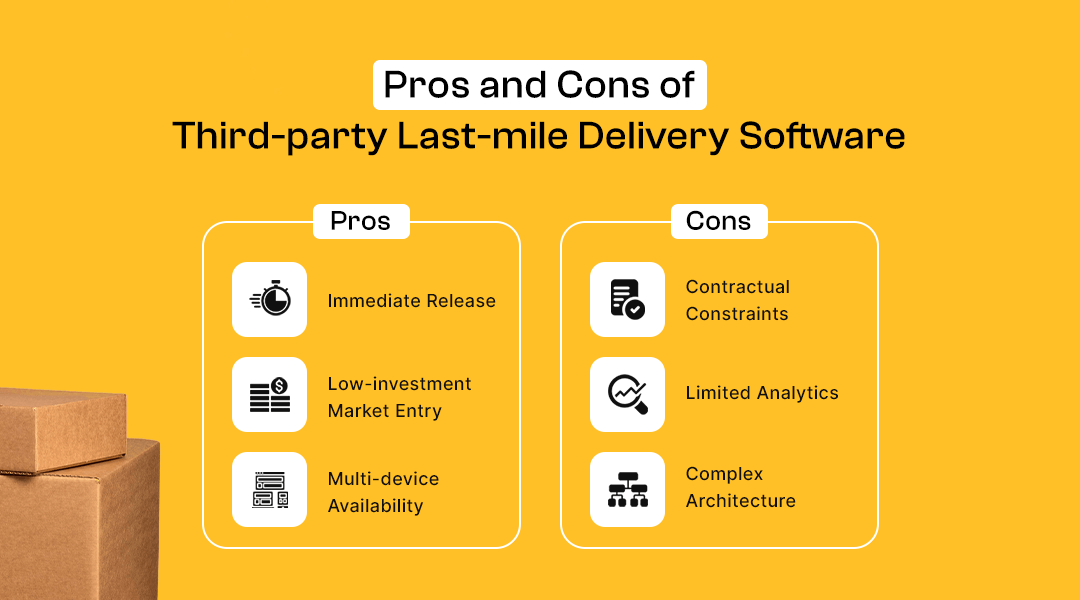
Advantages
A) Immediate Release
Since third-party software are readily available with the vendors, they can be immediately utilized. Implementing these solutions is merely a matter of hours, if not less. This is the polar opposite of custom-developing last-mile delivery software, where you have to wait for months to get the software.
B) Low-investment Market Entry
Last-mile delivery software vendors code the solution once and sell it to multiple businesses. As a result, the cost of this software is extremely low. In most cases, you have to pay a subscription fee (usually charged on a monthly or annual basis) to use the software.
C) Multi-device Availability
Most third-party last-mile delivery software comes with in-built mobile phone integration. This means that you can access the software’s functionalities on the desktop as well as a mobile device. This factor is beneficial when it comes to remote logistics management.
Disadvantages
A) Contractual Constraints
Third-party last-mile delivery software vendors sell their solutions on a contractual basis. As a result, there are certain contractual constraints related to data use, privacy, etc. that you have to oblige in order to keep using the software. However, doing so can potentially put your business’s integrity at risk.
B) Limited Analytics
Using last-mile delivery software comes with tremendous data collection. This data is extremely useful for strategic planning and decision-making. However, third-party software provides limited access to data and analytics. This restrains businesses from fully leveraging the software technology and growing their business.
C) Complex Architecture
Proficiently using a software can often be tricky, especially for first-time users. This is usually the case with third-party software solutions. These software usually come with a large number of features and functionalities, most of which are alien to logistics businesses. As a result, businesses have to spend additional time understanding these features to efficiently operate the software and harness its benefits.
These were the pros and cons of using third-party last-mile delivery software. Moving forward, we will understand the concept of custom-developed last-mile delivery software.
2. Custom Last-mile software
This approach involves undertaking last-mile delivery software development from scratch. As opposed to third-party solutions, you can create a software that perfectly aligns with your requirements by going with the custom development approach. All you need to do here is build an in-house development team or outsource last-mile delivery software development to an external vendor. Either way, you are guaranteed to get a top-quality last-mile delivery software for your business.
However, is a custom-tailored software better than third-party las-mile software? Let’s find out by weighing down the pros and cons of this approach.
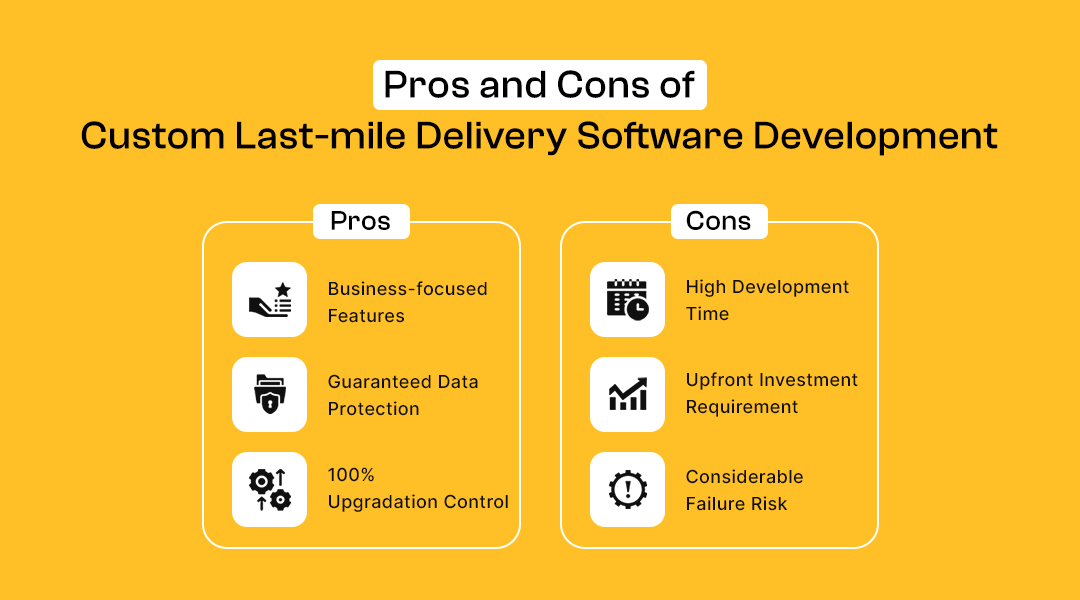
Advantages
A) Business-focused Features
When you develop last-mile delivery software from scratch, you get to choose the type of features in the software. You can choose to add only the features that serve a purpose for your business. This approach is beneficial for controlling the development cost and maintaining a sustainable software complexity.
B) Guaranteed Data Protection
Custom-engineered last-mile delivery software comes with ensured data protection. This means that you can stay assured that your data is not being sold to third parties. This usually happens when businesses choose third-party software. Most of these software sell data to other parties, hence opening a window for data exploitation.
C) 100% Upgradation Control
Staying relevant to the latest market needs is essential when it comes to technology. When planning to design and develop last-mile software from scratch, you get complete control over software upgradation. Simply put, you can add new features and functionalities to your software at any time to expand its usability. This is not possible with third-party software, where you are left at the vendor’s discretion for such technical upgrades.
Disadvantages
A) High Development Time
Developing a software from scratch is a time-consuming process. You have to precisely follow all the stages of the SDLC to successfully build a software. This directly contributes to the overall time it takes to release your last-mile delivery software. However, in the end, you are certain to get a high-end software for your logistics business.
B) Upfront Investment Requirement
When planning last-mile delivery software development, it is important to take capital investment into consideration. Creating a software requires a tremendous upfront investment. This is because you need to set up an optimal infrastructure before you begin the development process.
However, do note that this is not the case with last-mile delivery software development outsourcing. This approach enables businesses to initiate the software development process without investing a large amount upfront.
C) Considerable Failure Risk
It is worth noting that when going with custom-engineered software, there is always a considerable failure risk. Any pitfalls in the initial market research or idea validation phase can impact the overall quality of the software solution. This, in turn, can be detrimental to your business and cause hindrances in the overall logistics processes.
These were the advantages and disadvantages of custom last-mile delivery software development and third-party solutions. By now, it is clear that custom development outshines third-party solutions in numerous ways. While there are certain limitations to custom development, they are mostly negligible. This makes custom-engineered solutions an excellent choice. As a result, this blog will focus solely on custom last-mile software solutions.
Now that you know which approach is ideal for your project, it is time to go ahead and discuss the exact advantages of developing last-mile delivery software. This will be our topic for the coming section.
Benefits of Last-mile Delivery Software Development
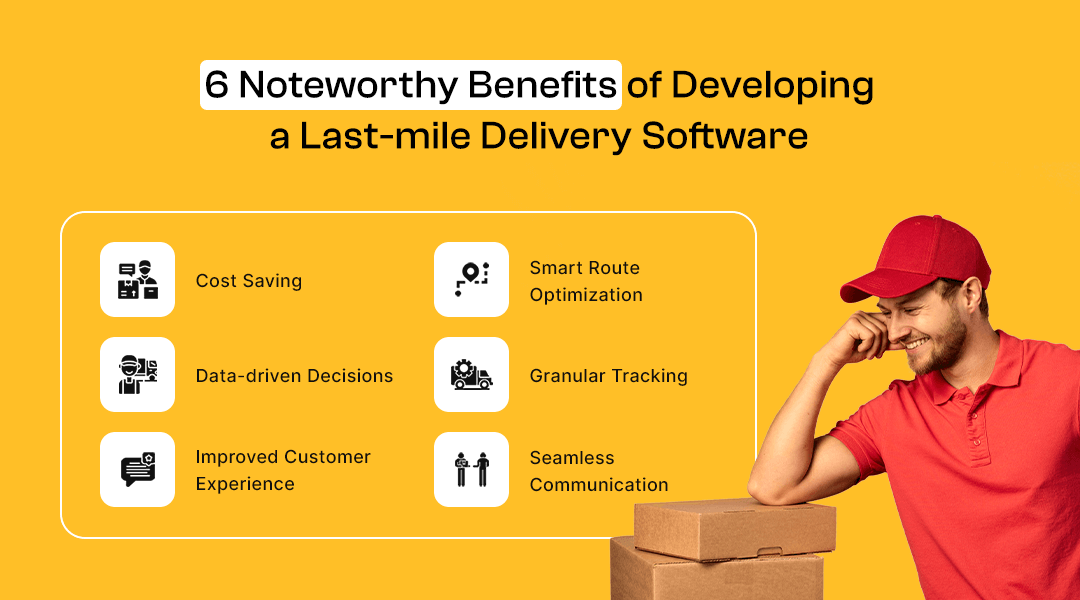
Earlier, we discussed the need for a software solution for last-mile delivery. Owing to the increasing demand for online shopping, the LPSs and transportation businesses are under more pressure than ever before.
As a result, the requirement for high-quality last-mile delivery software is higher than ever. This section will highlight all the ways in which your logistics business can benefit from a last-mile delivery software, so make sure to read carefully.
1. Cost Saving
Earlier, we discussed that last-mile delivery is the least cost-efficient part of the entire shipment process. Speaking in numbers, the share of last-mile delivery in the total shipment costs can be as high as 53%.
This is because allocating dedicated resources to deliver a single parcel to a customer’s doorstep can often be infeasible and increase shipment costs. In the end, it is the logistics service provider that has to bear this cost, directly impacting their profitability.
However, with delivery software development, you can easily save a tremendous amount of money on last-mile delivery. These software are capable of creating a delivery strategy that helps logistics service providers streamline deliveries with efficiency. This is possible by clustering deliveries in nearby localities.
This way, you can improve delivery efficiency and save costs. Moreover, last-mile delivery software automates numerous monotonous processes. This can reduce your overall human resource requirement, further aiding cost efficiency.
2. Smart Route Optimization
One of the most common challenges that logistics businesses face is establishing an efficient route to reach the delivery address. This route needs to be as short as possible and not have traffic congestion. Doing so is important to ensure speedy delivery with the least possible time and fuel consumption.
However, this is easier said than done. With manual route planning, there is very little that logistics businesses can do for route optimization. As a result, most delivery personnel end up taking lengthy and congested routes, losing efficiency. Last-mile delivery software development, on the other hand, is useful for smart route optimization.
These software are capable of determining the best course of route to reach a particular delivery address. The route is mapped based on factors such as real-time traffic analysis, average congestion, closures, weather conditions, etc. Moreover, these software can optimize the route in real time, ensuring top-notch accuracy. This way, you can improve delivery speed and even maximize ‘deliveries per day’.
3. Data-driven Decisions
Powerful decision-making is the cornerstone of a business’s success. In fact, businesses that are unable to make the right decisions at the right time are bound to fail, sooner or later. This is especially the case with the dynamic and fast-paced 236.
Operating a logistics business requires quick and powerful decision-making. However, with manual processes, these decisions often lack preciseness or backing. This is another area where last-mile software can help LSP businesses succeed. Last-mile delivery software application development enables businesses to harness the power of data-backed and smart decision-making.
When integrated with technologies like machine learning and artificial intelligence, these software can do miracles for your business. Briefly put, a last-mile software can help you make decisions and plan infallible strategies. These decisions are based on the technology’s capability to learn from historical data and patterns to forecast outcomes.
4. Granular Tracking
Tracking is an important part of the overall shipment process. Keeping a tap on the delivery’s progress helps LSPs plan their warehousing and staffing requirements and streamline resource utilization. Moreover, the customer, too, prefers precise tracking and anticipating their parcel’s delivery. While it is easy to track the entire delivery process, this is usually not the case with last-mile delivery.
This is because, without an optimal tracking system, there is possibly no way to get detailed information on the delivery personnel’s location and expected arrival time. However, you can overcome this challenge by developing a last-mile delivery software. These software enable logistics companies and consumers to track the delivery at a granular level. Enabled with technologies like GPS, this is the most prominent advantage of building a software.
Doing so can help LSPs keep track of the delivery personnel’s efficiency, ensure optimal productivity, and even maintain performance records. In the end, you will be able to determine whether or not the delivery personnel is performing well in their job, all with the help of a software.
5. Improved Customer Experience
Customer experience holds a distinguished position in the logistics industry. Every logistics business aims to excel in this area and impress its customers. However, doing so is rather challenging when operating with manual processes. This is because manual logistics processes are prone to human errors and negligence. This often results in customer dissatisfaction and negatively impacts their experience.
This is another popular reason why last-mile delivery software development is becoming more and more popular. These software can be integrated with numerous functionalities and features that focus on improving CX in the final-mile delivery stage.
These software enable consumers to get complete shipment information at their fingertips. Moreover, the customers can even raise tickets and easily file refunds, most of which are automatically handled with these software.
Do note that doing so often requires integrating the software with a website or a mobile application. Nevertheless, a last-mile software is certain to help you uplift CX and deliver a state-of-the-art last-mile delivery experience.
6. Seamless Communication
Out-and-out communication efficiency is important for a successful and efficient last-mile delivery. This includes a streamlined communication thread between the LSP, delivery personnel, and customers. This way, the three parties can seamlessly interact with each other and ensure that the last-mile delivery is completed successfully.
The best way to achieve this level of communication efficiency is to build last-mile delivery software. This software enables multiple parties involved in the shipment process to communicate with each other and share information in real time.
Moreover, last-mile delivery software can also be used to raise alerts and send delivery update SMS to customers. In the end, you are certain to experience best-in-class communication efficiency by using last-mile software.
These were a few noteworthy advantages that make developing last-mile delivery software a great idea. Now that you know why you should develop a software for last-mile delivery, it is time to discuss the key features and functionalities that you will need to actually build the software. The coming section will shed light on this topic.
Key Features to Include in a Last-mile Delivery Software
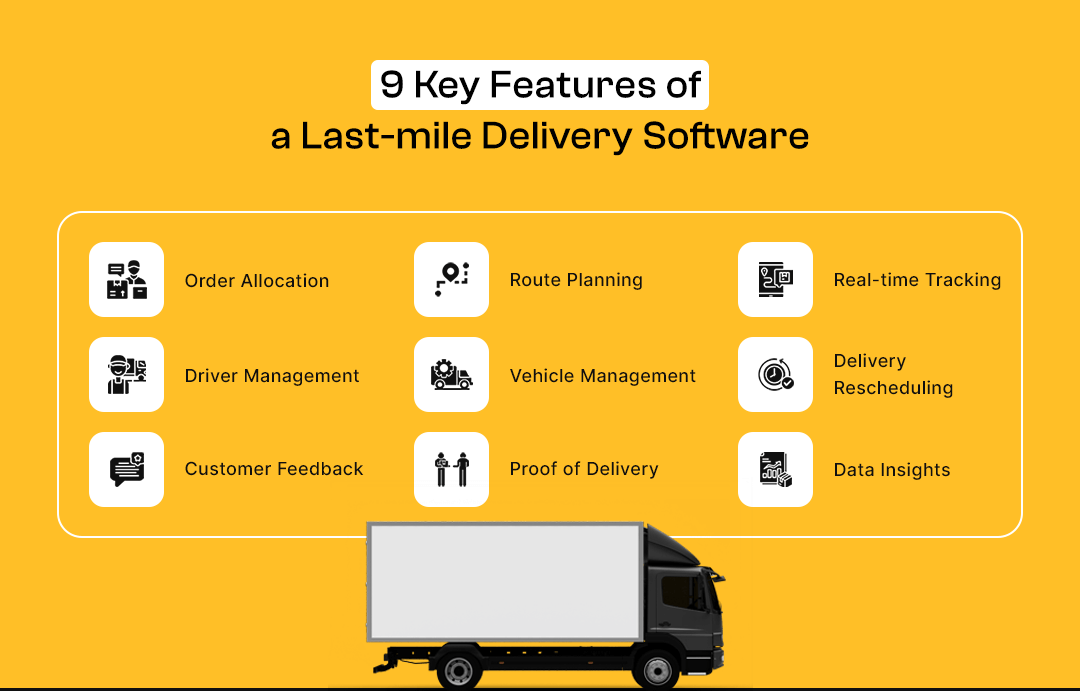
When planning to create a last-mile delivery software, it is essential to choose the right set of features and functionalities. Doing so will help you leverage the software solution and make the most out of it.
While the exact features of your software will vary with your business’s requirements, there are certain common features that will remain the same. In this section, we will discuss the most common features of last-mile software.
1. Order Allocation
The first and foremost feature for last-mile software development is order allocation. This feature automatically allocates an order’s delivery to an available delivery personnel.
The allocation decision is based on numerous factors, such as the order’s weight, delivery demand, delivery location, and more. Once analyzed, the system automatically chooses the most optimal delivery personnel, time slot, and vehicle for the delivery.
2. Route Planning
Route planning is an important feature in last-mile delivery software application development. This feature enables the software to automatically plan the best course of route for delivery. This route is planned keeping factors like current traffic congestion, future traffic, weather, closures, and delivery address into consideration.
The smart route planning feature is laser-focused on delivering maximum orders with minimal driving. This can be a make-or-break factor for your business and requires optimal focus.
3. Real-time Tracking
The real-time tracking feature enables LSPs, as well as customers, to track last-mile delivery in real-time. Based on GPS, real-time tracking displays the driver’s location on a map and enables users to get an estimated delivery time.
An optimally developed real-time tracking feature can make the lives of the customers as well as businesses easier. This is because this feature can reduce the number of calls that customers have to make to enquire about the latest delivery status. Moreover, there is no doubt that getting real-time delivery updates can improve the overall CX.
4. Driver Management
Driver management is one of the most important features of last-mile delivery software. When planning to develop a last-mile delivery software application, a delivery management system is what controls the driver’s tasks, trips, and deliveries.
An optimally coded driver management system is what ensures that all the drivers are working efficiently and optimally. This feature also enables drivers to know if any parcel is scheduled for priority delivery or if any delivery has been rescheduled.
5. Vehicle Management
Another important feature of delivery software development is vehicle management. This feature provides an updated status on all the delivery vehicles. This includes whether or not the vehicle is available for delivery, its delivery schedule, etc.
It is a great practice to enrich this feature with more information, like the vehicle’s maintenance requirements. This functionality can significantly help logistics businesses ensure optimal vehicle availability and avoid delivery delays due to vehicle breakdowns.
6. Delivery Rescheduling
Many times, customers need to reschedule their parcel’s delivery. This usually happens in case of emergencies and certain other unforeseen circumstances. In this situation, delivery rescheduling becomes an important feature for last-mile delivery software development.
This feature enables LSPs to reschedule deliveries easily and without losing operational efficiency. You can use this feature to ensure that the customers receive the delivery at their preferred date and time and further optimize their last-mile delivery experience.
7. Customer Feedback
Receiving customer feedback is an important part of last-mile delivery. This feedback can help you understand consumer perception of your last-mile delivery processes and even take steps to improve the delivery experience.
Therefore, when planning to develop last-mile delivery software, it is important to take customer feedback features into consideration. This feedback will help you turn customer data into visualized information on trends, behavior, and more.
To add to that, this feature can also be useful for handling customer grievances, providing resolutions, and more. In the end, you will be able to effectively improve customer relations, all with the help of a single feature.
8. Proof of Delivery
Proof of delivery is an essential part of the last-mile delivery process. In lay terms, proof of delivery is a document that acts as evidence that the parcel has been delivered to the customer. In terms of last-mile delivery software application development, proof of delivery acts as a central record of delivery evidence. This evidence serves as a database through which the LSPs can seamlessly maintain delivery records.
9. Data Insights
Using software solutions comes with numerous advantages. One of the most significant of these advantages is automatic data collection and analysis. By investing in last-mile software solutions, you can harness the benefits of data collection. This data serves as insights into the business’s performance, last-mile delivery efficiency, and consumer experience.
You can then use this data to streamline decision-making and create powerful strategies. All of this is possible through the data analytics dashboard of the last-mile delivery software.
These were some of the key features to keep in mind when planning last-mile delivery software application development. Of course, the exact features of your solution will depend on the type of last-mile software that you wish to develop.
We, therefore, recommend you consult with an experienced last-mile software design and development company like Auxano Global Services for your project. We hold 10+ years of experience in custom-engineering world-class last-mile delivery software.
Based on the type of features that you wish to develop, you will need to choose technologies for your last-mile software. However, how does one know which technologies are the right fit for a software? If you, too, have this question, keep on reading. The coming section will shed light on commonly used technologies for custom last-mile software engineering.
Technology Stack for Last-mile Delivery Software Development
Every software project requires a technology stack. In simple words, this technology stack is the set of tools, technologies, languages, frameworks, etc. that will be needed for engineering a software.
The technology requirement to develop a last-mile delivery software for your business will depend on your requirements. However, owing to our domain experience, we can provide you with basic information on the popularly used technologies.
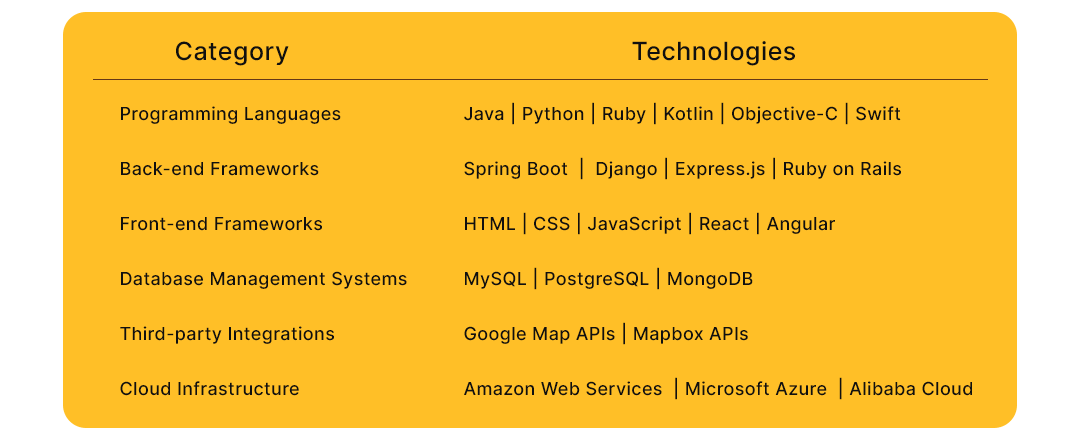
These were a few technologies that you can use for building a last-mile delivery software. Do note that if you wish to integrate your software solution with advanced technologies, the technology requirements will be different.
In case you want to know more about this subject, read till the end. We have provided detailed information on next-gen technologies for last-mile delivery software in the later section.
So far, we have provided information on the key aspects of last-mile delivery software. We are sure that by now, you know why exactly it is a great idea to build a last-mile delivery software. Moving forward, we will be looking at the actual process of engineering a last-mile software.
6-step Last-mile Delivery Software Development Process
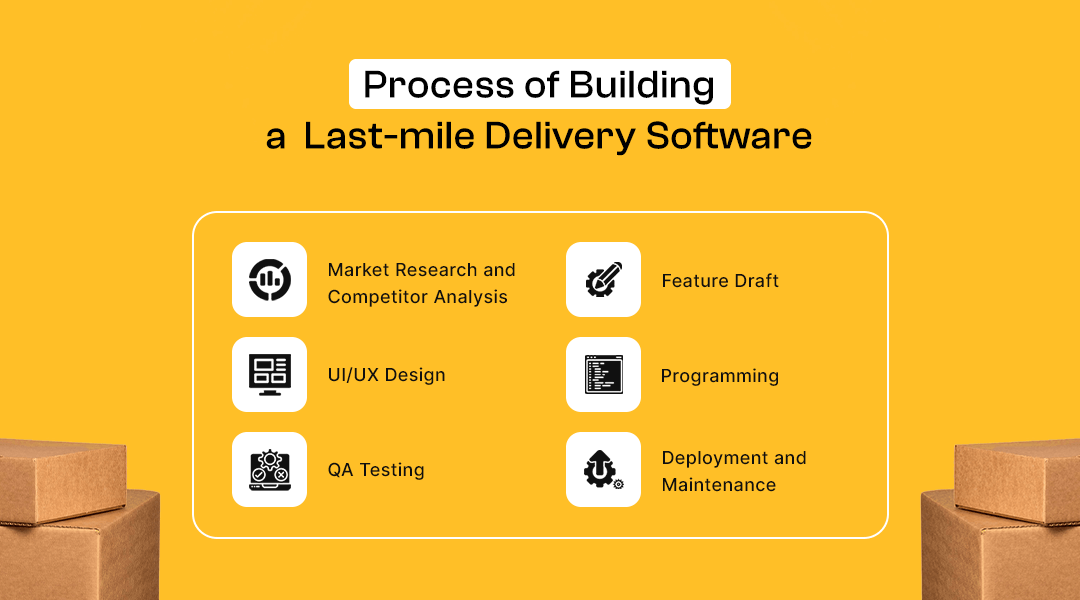
The process of developing a last-mile delivery software passes through numerous stages. Each of these stages adds some value to the final software solution. In this section, we will understand the role of each step in creating a successful last-mile delivery software.
1. Market Research and Competitor Analysis
The process of engineering a software starts with concept ideation. Here, you have to come up with a software idea that you want to launch in the market. Here, our product idea is a last-mile delivery software. Once you know what you want to develop, you can go ahead and conduct market research for your idea.
Doing so will enable you to understand whether or not your software idea is feasible enough to be launched in the market. Moreover, this stage also includes competitor analysis, where you analyze your competitor’s product and weigh your ideas against theirs. Analyzing your competitors will enable you to determine industry needs, understand market gaps, determine KPIs, and more.
Overall, market research and competitor analysis are important to lay a strong foundation for the software idea. You can use this foundation to streamline SDLC and seamlessly develop a last-mile delivery software application.
2. Feature Draft
Once you have conducted the market research, you will be left with a lot of information on last-mile delivery software. One such information is the features that your competitors are using in their last-mile delivery software. Let us tell you that these features can be a make-or-break factor for last-mile delivery software development.
We had outlined the key features of last-mile delivery software in the previous section. However, the exact features of your solution will depend on your business’s unique requirements. We recommend that you carefully select the features for your software solution. The right choice of features will also depend on your technical capabilities, business scope, time & capital availability, among other factors.
By the end of this step, you will have a list of features that you want to integrate into your last-mile delivery solution.
3. UI/UX Design
Once you know the type of feature that you want to develop, you can go ahead and plan user journeys. These user journeys will determine how the end-users will utilize these features. Briefly put, this phase of the SDLC is known as UI/UX design.
To create a remarkable last-mile delivery software UI/UX design, there are numerous factors to keep in mind. Some of these factors are usability, functionality, practicality, and visual appeal. Balancing these factors will enable you to create an enchanting user interface for your last-mile delivery software.
Do note that the final software will largely depend on the UI/UX design that you create. As a result, you must be careful while crafting a UI for your software. This can be done by following a systematic design process and regularly testing the UI design for bugs and errors. Once you have designed all the screens of your software, you are ready to code the actual program.
4. Programming
This is one of the key stages of the last-mile delivery software development process. Here, you have to code the actual program that will be used as the last-mile delivery software. This is the stage where you will use the technology stack discussed in the previous section.
The higher the quality of your code will be, the better your software will perform. Nevertheless, this is one of the most time-consuming parts of the entire SDLC. Do note that you can reduce this time requirement by adapting agile methodologies and frameworks like Scrum and DevOps. Doing so will help you code and test your program in chunks, therefore merging the programming and QA testing phases.
If you choose not to work with agile methodologies, you can go ahead and program your app, followed by separate QA testing.
5. QA Testing
Once you have finished the core last-mile delivery software development, you can go ahead and test the code. Doing so will help you detect and rectify the pitfalls and loopholes in the program and improve its performance. QA testing is an essential part of the overall SDLC.
Once tested, debugged, and compiled, your code is ready to be released. By now, you have a well-functioning program that can be used for managing last-mile deliveries.
6. Deployment and Maintenance
Merely releasing the software is not the end of the SDLC. After the release, you need to undertake continuous last-mile delivery software maintenance and upgradation. Here, you need to add new features and functionalities to your software.
Continuous upgradation and maintenance is the key to ensuring that your last-mile delivery software is up-to-date with industry demands and is working optimally. Many software tend to develop bugs over time due to technological obsolescence. Periodic maintenance will help you keep these bugs at bay and work with a flawless last-mile delivery software.
This was it for the process of creating a last-mile delivery software. You can follow this process and build the software yourself or even outsource last-mile delivery software development to an external vendor. We recommend the latter approach and suggest that you get last-mile software development services from an experienced agency like Auxano Global Services.

Either way, you have to invest a certain amount of money in the process. This is one of the most important parts of custom last-mile delivery software development. In the following section, we will discuss the software development costs in detail.
Last-mile Delivery Software Development Cost: Understanding Capital Investments
Most people planning to go with last-mile delivery software development wonder about the costs of the process. Let us tell you that there is no single answer to this question. The costs for a last-mile delivery software depend on a case-by-case basis.
Nevertheless, if you are looking for estimates, we can provide you with rough figures. The cost of building an average last-mile delivery software can range from USD 15,000 to USD 300,000. This is a wide range, right? That’s because this cost depends on numerous factors.
A few important factors that can influence this cost are:
- Location of the development team
- Software developer’s experience
- Number of developers working on the product
- Features and their complexity
- Software’s architecture complexity
- Technology stack, and more.
Therefore, we recommend that you get in touch with an experienced last-mile software development company and get a quotation for your requirements. At Auxano Global Services, we offer cost-effective and competitive quotations for every project requirement.
So far, we have covered everything that you need to know while creating software for your last-mile delivery processes. As stated earlier, we will be providing some additional information on high-end technologies for last-mile delivery software. Keep on reading to know about these technologies.
Bonus: Technologies to Revolutionize your Last-mile Delivery Software
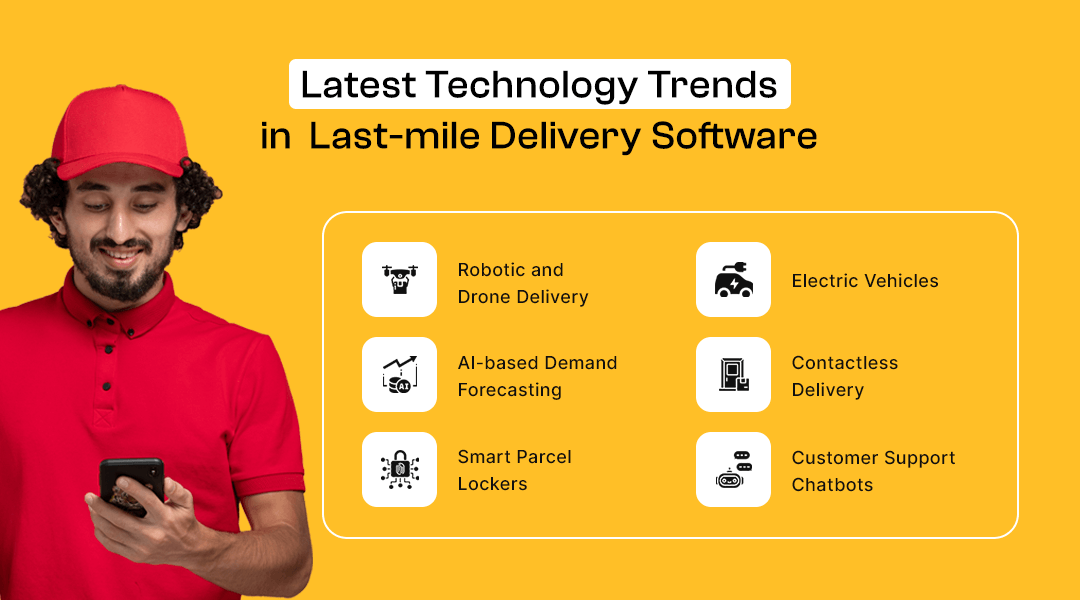
Next-gen technologies like AI and ML are revolutionizing the logistics industry. The most recent applications of such technologies are visible in last-mile delivery.
Here, we have discussed some of the key technologies that can be integrated with last-mile delivery software. You can use these technologies to take your final-mile delivery solution to the next level and enhance the delivery experience and efficiency.
1. Robotic and Drone Delivery
Nowadays, more and more people prefer interacting with technology over with real people. Owing to this factor, robotics are becoming more and more popular in industries like hospitality, dining, healthcare, etc. The logistics industry is no exception in this matter.
When developing last-mile delivery software, it is important to keep the scope of robotics and drones into consideration. These technologies, while being highly modern, are highly efficient and reliable. Drones are excellent for optimizing the last-mile delivery process. This is because of the fact that drones can beat the traffic and reduce delivery time by traveling to the customer’s location via air. Moreover, delivery robots can be efficiently used for vehicle-to-door delivery.
2. Electric Vehicles
Electric vehicles are another popularly used technological advancement in the logistics sector. Owing to the growing demand for green deliveries, using electric vehicles has become a popular trend, especially for last-mile deliveries.
As opposed to motor vehicles, electric vehicles are not fueled by petroleum products. Instead, these vehicles work on electricity and, therefore, have zero tailpipe carbon emissions. Naturally, electric vehicles have a relatively smaller carbon footprint than motor vehicles. To add to that, electric vehicles are more cost-efficient and, therefore, can significantly reduce the cost of last-mile deliveries.
3. AI-based Demand Forecasting
Demand uncertainty is one of the most pressing challenges in last-mile delivery. This uncertainty in demand restricts LSPs from pre-planning their resource requirement and ultimately leads to compromised business efficiency. However, AI technology is an effective solution to this challenge.
When planning last-mile delivery software development, you can simultaneously enable AI integration. The AI technology, owing to its smart nature, can precisely predict future demand based on past data. This prediction is made based on factors like seasonal requirements, customer demographics, business trends, etc. In the end, you will be able to forecast future demands and prepare your business accordingly.
4. Contactless Delivery
We live in a post-COVID world where safety and well-being are the priority of LSPs. This includes the safety of the delivery personnel as well as the customers. Owing to this factor, more and more logistics companies are opting for no-contact delivery. From dropping off the parcel at the customer’s doorstep to using delivery robots, no-contact delivery is a growing market.
However, the most common challenge in contactless delivery is ensuring an optimal final-mile delivery experience. For this reason, you can develop a last-mile delivery software application with features like delivery notifications and digital Proof of Delivery. Doing so will help you offer a contactless last-mile delivery experience while ensuring logistics efficiency.
5. Smart Parcel Lockers
It is true that last-mile delivery is one of the most risky processes in the entire supply chain. This is because of the numerous cases of thefts and parcel alterations that commonly take place in this last-mile delivery. The best way to overcome this challenge is to use smart parcel lockers.
These lockers ensure that the parcel is safe and secure throughout the last-mile delivery process. Smart lockers preserve the integrity of the package and enable customers to stay assured of their quality. This makes smart lockers an excellent technological advancement for last-mile software solutions.
6. Customer Support Chatbots
So far, we have discussed the importance of customer experience in last-mile delivery numerous times. It is now clear that delivering a high-end customer experience is essential for the success of a logistics business. However, delivering an exceptional customer experience for every delivery is challenging for large-scale LSPs.
In this case, it is a great idea to automate certain aspects of CX, like customer support, using technologies like chatbots. These chatbots are highly smart in nature and can be used by logistics companies to provide precise information to customers.
In the context of last-mile deliveries, chatbots can provide customers with information like real-time parcel location, expected delivery time, driver information, etc. Moreover, these chatbots can also be used for functions like delivery rescheduling, proof of delivery emailing, and more.
Summing It Up: Last-mile Delivery Software Development
Developing last-mile delivery software is a popular practice among logistics service providers. These software enable logistics companies to align their business processes with growing organizational needs while also aiding process efficiency.
This blog provided detailed information on last-mile delivery software application development. By now, you are aware of some critical aspects of the concept, like its benefits, features, technology stack development process, cost, and more.
You can use this information and start building your last-mile delivery software. Alternatively, you can also approach an experienced software solution provider and outsource last-mile delivery software development. Doing so will help you harness the maximum benefits of the software without actually having to deal with the technical part of software engineering.
Ready to Build World-class Last-mile Software Solutions?
If you are planning to develop a turbocharged and feature-rich last-mile delivery software, you need a seasoned logistics software engineering partner with hands-on experience. Auxano Global Services holds proven domain experience in logistics and delivery software development and is a globally trusted technology partner. We custom-engineer powerful software based on our client’s requirements and industry trends.
Get in touch with us today to avail our custom last-mile software development services. You can email us your requirements at admin@auxanoglobalservices.com, and our experts will get back to you within 48 hours.

Frequently Asked Questions on Last-mile Delivery Software Development
1. Which industries can benefit from developing a last-mile delivery software?
There are numerous industries that can benefit from last-mile delivery software. This includes industries like logistics, food and dining, pharmaceuticals, E-commerce, and more. All of these industries can use a software solution to streamline the last-mile delivery process. You can get in touch with our experts today to learn more about how your business can benefit from last-mile delivery software.
2. How much will it cost to develop an MVP-level last-mile delivery software?
The cost of a last-mile delivery software varies from one requirement to the other. Different businesses have different requirements and, therefore, the exact scale of MVP depends on the exact business scope. Nevertheless, the MVP development cost to create a last-mile delivery software can range from USD 12,000 to USD 30,000.
3. Should I hire in-house software engineers or outsource last-mile delivery software development?
Whether to hire in-house software engineers or go with the last-mile delivery software development outsourcing approach depends on numerous factors. While in-house development is ideal for complex-level projects, outsourcing is preferred for controlling project costs and aiding SDLC efficiency.
Generally speaking, outsourcing is the most preferred choice for building a software of any type. We therefore recommend you go with the outsourcing approach for your last-mile delivery software requirements.
4. How can I reduce my last-mile delivery software’s development cost?
There are numerous ways to reduce the last-mile delivery software development cost. Here are some of the most popular and time-proven ways:
- Choose the outsourcing approach
- Optimize cost with location
- Go with MVP development
- Choose an agile methodology
- Clearly define requirements and more
Adapting these approaches will enable you to control the costs of your project without compromising the final product’s quality.
5. Does my last-mile delivery software also need a mobile application?
When planning last-mile delivery software development, it is a popular practice to simultaneously develop a mobile app. Doing so will help you add mobility to last-mile delivery management, improve the software’s capability, and enhance business productivity. Mobile solutions, when integrated with a software, can turn out to be beneficial in numerous aspects.
Therefore, it is a good idea to integrate your last-mile delivery software with a mobile application. However, as a word of caution, we do not recommend this approach in case you are still testing your software idea and are uncertain about its success.



